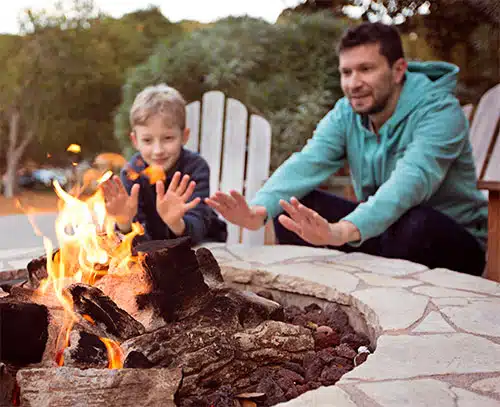Outdoor firepit designs are becoming a must-have addition to many modern homes. They enhance the appeal of outdoor living spaces, adding warmth and ambiance. This article explores the considerations for choosing an outdoor firepit, comparing gas and wood-burning options to help homeowners choose the perfect fit for their space and budget.
Outdoor Firepits: Gas vs. Wood – What You Need to Know

There are fundamental differences in fuel source, operation, and design between gas and wood outdoor firepits. Choosing an outdoor firepit depends on personal preferences regarding convenience, aesthetic appeal, and the experience you wish to create in your outdoor living space. Both have their unique qualities, making them popular choices among homeowners.
Fuel Source and Operation
- Gas Firepit: They use liquid propane or natural gas as fuel. Starting and controlling the fire is as simple as turning a knob or pressing a button. Gas outdoor firepits are convenient for quick, clean burning without the hassle of maintaining a fire.
- Wood Firepit: These classic firepits use wood logs as fuel, requiring physical effort to build and maintain the fire. They offer the traditional experience of an open flame, complete with the aroma of burning wood and the sound of crackling logs.
Design and Aesthetic Appeal
- Gas Firepit: Typically features a modern and sleek design, offering a range of styles from minimalist to elaborate. They can be central in contemporary outdoor settings, often equipped with artistic elements like glass beads or decorative lava rocks.
- Wood Firepit: Tend to have a more rustic, traditional appearance. They can range from simple metal bowls to elaborate stone structures, providing your outdoor space with a natural and earthy feel.
Unique Experiences
- Gas Firepit: Known for their ease of use and cleanliness. They don’t produce smoke, making them ideal for environments where smoke might be a concern. Gas outdoor firepits are perfect for those who prefer a hassle-free and clean experience.
- Wood Firepit: Offer a sensory experience that gas firepits can’t replicate. The smell of burning wood, the hiss of crackling logs, and the warmth of a wood flame create a cozy, campfire-like atmosphere. They are ideal for those who enjoy the traditional aspects of an outdoor fire.
Pros and Cons Analysis

The Upside of Gas Firepits
- Ease of Use: Gas firepits are remarkably user-friendly, featuring quick start-ups with push-button ignition and no need for constant tending.
- Low Maintenance: They require minimal upkeep due to the absence of ashes or debris typical of wood firepits.
- Environmental Friendliness: Gas firepits are cleaner, emitting fewer pollutants than wood firepits, making them a greener choice.
- Continuous Operation: They can run continuously without constant refueling, ensuring a consistent experience.
- Smoke-Free Enjoyment: Ideal for those sensitive to smoke, gas firepits offer a clean burn without the smoky aroma.
The Drawbacks of Gas Firepits
- Higher Costs: The initial investment for a gas firepit, including installation, is generally higher than that of a comparable wood firepit.
- Complex Installation: Professional installation may be required, especially for natural gas firepits, which can add to the cost and planning required.
- Cooking Limitations: While some gas firepits offer limited cooking capabilities, they can’t match the versatility of wood firepits in this regard.
- Dependency on Fuel Supply: They rely on a consistent supply of propane or natural gas, which might be a constraint in some areas.
Benefits of Wood Burning Firepits
- Traditional Ambiance: The classic appeal of wood firepits, with their natural aroma and crackling sounds, offers an authentic experience.
- Heat Output: Wood firepits typically provide more heat, making them ideal for colder nights.
- Cooking Capabilities: They offer a broad range of cooking options, from roasting marshmallows to grilling, adding to their versatility.
- Affordable Setup: Generally, wood firepits are less expensive to purchase and install than their gas counterparts.
The Cons of Wood Burning Firepits
- Regular Maintenance: They require more upkeep, including cleaning out ash and managing logs.
- Environmental Impact: Wood firepits emit smoke and other pollutants, contributing to air pollution and potentially affecting health.
- Fire Hazards: With open flames and flying sparks, wood firepits pose a higher risk of fire accidents, especially in dry conditions.
- Rely on Wood Being Available: Maintaining a steady fire requires regular attention and an ongoing source of ready-to-burn wood.

Key Considerations
When choosing an outdoor firepit, it’s essential to consider several key factors:
- Cost: Wood firepits typically range from $300 to $1,300, while gas firepits are more expensive, ranging from $900 to $3,800. This includes the cost of materials and installation, which is generally higher for gas firepits due to the need for professional installation and gas lines.
- Installation: Gas firepits require a professional installation, especially for natural gas lines, adding to the cost and complexity. Wood firepits can be a DIY project but are safer when professionally installed.
- Maintenance: Wood firepits require more maintenance, involving regular cleaning of ash and logs. Gas firepits are low maintenance, needing occasional wiping of the exterior.
- Environmental Concerns: Gas firepits are cleaner, emitting fewer emissions than the smoke and pollutants from wood firepits. This makes gas firepits a more environmentally friendly option.
- Resale Value: Gas firepits can enhance the resale value of a home due to their eco-friendliness and modern appeal. While wood firepits also add value, they generally add less financial value than gas firepits.
- Local Regulations and Permits: Some areas restrict the type of firepit allowed. Wood firepits may be subject to burn bans or open flame restrictions, while gas firepits might need specific permits for gas line installation.
Enhancing Your Space with the Right Outdoor Firepit
When choosing an outdoor firepit, your personal preferences play a crucial role. Balance your decision with practical considerations like budget, available space, and intended use. Both gas and wood outdoor firepits can transform your backyard into a cozy, inviting haven. Selecting a firepit that aligns with your lifestyle and aesthetic preferences is important, ensuring a perfect addition to your outdoor living space.
Looking for more ideas and inspiration to enhance your outdoor spaces? Contact Yardsy for a wealth of information and tips on creating the ideal outdoor environment for your home.



















































